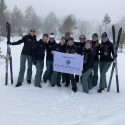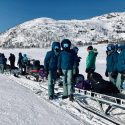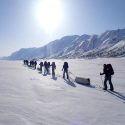FORCES WIVES CHALLENGE HEROES OF TELEMARK EXPEDITION MARCH 2022
From 13-24 March 2022 Forces Wives Challenge (FWC) took a team of 12 ladies to Norway in an attempt to become the world’s first all-female team to re-enact the famous Heroes of Telemark (HOT) – a WWII mission by Norwegian Special Forces across the Hardangervidda Plateau. It was conducted by a small team of brave men who risked their lives to successfully sabotage Hitler’s plans to create an atomic bomb and thereby changing the course of history.
The FWC team was made up of women from the fields of healthcare, life sciences, aerospace, business coaching, Defence, make-up artistry, clinical research and sports rehabilitation. It was organised by Major Heather Sharp – an ex-regular, now reservist officer who the Ulysses Trust kindly sponsored.
The expedition was split into 2 phases: Phase 1 was training and preparation and Phase 2 the Heroes of Telemark re-enactment.
PHASE 1 – TRAINING AND PREPARATION
A third of the team had never skied before and only two had cross-country skied – none had ever pulled a pulk so the training phase was critical. The instructors, Matt Larsson-Clifford and Glyn Sheppard, had their work cut out! In three days the team were taught a variety of skills from stopping, turning, skiing with a rucksack, to the importance of teamwork, being self-reliant, self-disciplined and the word of the trip, ‘efficiency’ – making sure everything the team did, they did as efficiently as possible to save energy. The group was split into three pulk teams and the final day was all about kit prep, packing the rucksacks and pulks and learning how to use all the kit. The ladies were ready for the Vidda!
PHASE 2 – HEROES OF TELEMARK RE-ENACTMENT
DAY 1
It would be a three-hour drive from the training area in Evje to where the team would meet the ski-doos that would take them onto the Vidda. All the kit and the 12 strong team were loaded onto trailers and taken the 30 km journey across the frozen lakes to their first hut – Fjærefit.
Lessons in hut admin were first on the list, an essential part of the expedition to create and keep a warm dry environment with enough water ready for drinking and preparing food. Each pulk team took a role, collecting snow, melting the snow for water, and chopping wood and tending to the fire. A sense of excitement bubbled through the hut as the team sat down to tell stories, play games and accustom themselves with the slower pace of hut life.
DAY 2
Setting off across the plateau to the second hut, Berunuten the team had their first experience of pulling pulks. They quickly settled into a routine of taking turns – 20 mins on, 5 mins off – and the team’s training was put to the test. Supported by each other the day ran smoothly,
“We actually found our rhythm quite well and made it to the hut in good time,” Jemma wrote.
Team members learnt quickly to patch up hot spots on their feet to avoid blisters, as well as the importance of sun cream. The final challenge of the day was the incline to the hut. Tired legs and heavy pulks added to the challenge however, with teamwork and cheers of encouragement the team made it to Berunuten. Straight into their hut admin roles the team could settle in for the night, dry their kit and refuel for the next day.
DAY 3
With a 23 km long day ahead of them, the team rose early to allow time to reach the third hut Rype Hytte in daylight hours. It was another beautiful day with clear blue skies which added to the stunning scenery and high morale. The team spotted moose and artic fox tracks but there were no other signs of life. The only sound was of their skis on snow and the occasional song to keep spirits up when the terrain got tough. An incident with Boo’s ski binding showed the team the importance of the emergency spare kit. Halfway up a hill and still attached to the pulk Boo noticed something was wrong:
“I was so preoccupied with getting the pulk up the hill when my ski binding came off, with my foot still attached I just kept walking and then I realised, this isn’t skiing!… It was a very slick process; no time was wasted which was important as the whole team was halfway up a hill and I didn’t want them to get cold.”
The team quickly resolved the issue replacing the ski with a spare from one pulk. Boo stayed cheery throughout and the team attacked the hill, wonky skis proving no problem for this pro-active team.
Shadowed by mountains, the temperature dropped and the wind picked up as the team skied further across the Plateau. Digging deep to complete the 10 hours ski, the ladies pulled together, many were cold and tired but knowing the team were behind them each member took their turn on the pulk and got themselves and their supplies to the safety of Rype Hytte.
Some took the opportunity to sleep in the lavvu tent, experiencing temperatures of -10 degrees. It was a restless night, but all part of the ‘Type 2 fun’ expeditions bring. That fun that it isn’t ‘fun’ at the time but when you reflect with friends later you forget the hardship and only recall the positive aspects!
DAY 4
The team had been prepared for this day – they had been told horror stories of the cold, windy valley that never sees sun and all were prepared for the worse. The weather however, was to spoil them, bright blue skies lit up the valley showing the route clearly in the icy snow. Although the weather was in their favour, conditions were still tough, sastrugi (rutted ice peaks) were painful under blistered feet, and previous injuries were playing on people’s minds.
Kaz wrote, “The scenery was dramatic and beautiful – a welcome distraction from the pain.”
The team lunched on top of a dam, after climbing its steep side using their ski skins. What goes up must come down and the team had to tackle an afternoon of descents.
“The downhill sections created carnage – pulks with their own personalities, head plants and several sense of humour failures – we needed to dig deep to get to our final overnight destination,” Kaz remembered.
The final hut Reinar Hytta was once owned by saboteur Jens-Anton Poulsson; a huge privilege for the team to stay the night. The team had their hut drills down to perfection, nobody needed to be told what to do but all got on with the task ahead and quickly the team were settled in.
DAY 5
Blisters patched and sore injuries taped up the team were ready for the off. Snow was falling and the light was low creating an other-worldly feel to the Hardangervidda. With the team facing deep snow and steep ascents, teamwork pulling and pushing the pulks was pivotal for getting the team to their destination.
“The teamwork and morale to get us (including the pulks!) up the steep ascents was incredible and a memory that will stay with me forever,” Hannah wrote.
A detour off route was taken to visit the memorial of Leif Tronstant and Gunner Syverstad where a prayer written by the Norwegian Ambassador’s wife, Reverend Cecile Strømmen was said and a poppy laid remembering the sacrifices of these brave men.
More huts and people started to appear as the team reached their finish line. The local town of Vierli was a welcome sight as was a restaurant serving hamburgers, a huge treat after surviving off nuts, chocolate, and dehydrated food for the last few days!
DAY 6
Well rested after a night celebrating their accomplishments, the team faced their final challenge, to recreate Operation GUNNERSIDE – the approach and attack route on the Vemork water plant. The team, dressed in white camouflage ski suits and wearing their skis took off down the valley. The route soon turned icy and the team stopped to fit their walking crampons, before descending further towards the plant. The terrain was difficult showing how skilled and resilient the saboteurs were to do this at night, in the depths of winter.
At the factory the team laid a wreath, kindly supplied by The War Widows’ Association charity, paying respect to the lives lost aiding this mission and the saboteurs who bravely defended their country and stopped Hitler’s mission to create an atomic bomb.
The final challenge for the ladies was the escape route, 500m up out of the valley. The team took on the challenge – 53 minutes, 21 bends and almost 4km of snowy, icy path later the team reached the top. Finishing the climb together, showing their determination, resilience, and dedication to their team – a true testament to the FWC moto,
“TOGETHER WE CAN ACHIEVE ANYTHING!”




